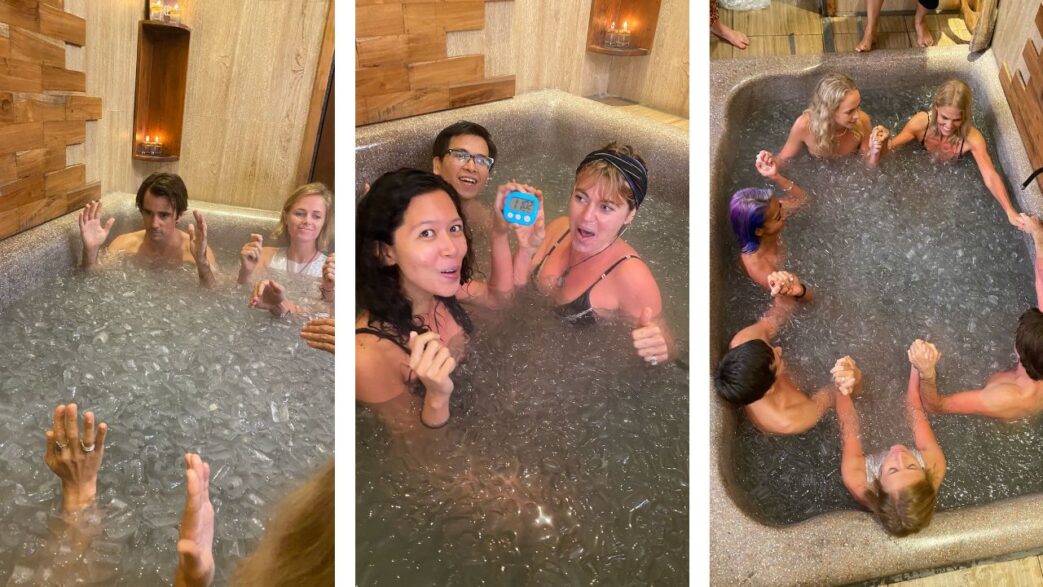Fall in love with ice baths. Really?!
The cold water immersion craze that has taken over the health and wellbeing world over the past couple years has deep roots in historical and cultural practices.
All around the world, throughout times, people have played with cold water for health and vitality.
From ancient Egypt to ancient Greece, to the Nordic and Scandinavian countries, to the Renaissance – and fast forward to the 21 century and we have an explosion of interest in this rather intense practice especially thanks to folks like Wim Hof.
There are so many benefits to ice baths – a lot backed by research which includes muscle recovery, reduced soreness, improved mental health, immunity and sleep.
Over the years I have facilitated ice baths for more than a thousand people as well as teaching ice bath facilitation as part of BreathingCold’s Breathwork Facilitator Training.
I’ve found the ice bath is such a practical tool to work with so many things in life – such as fear, resistance, discomfort, pleasure, pain, stress, emotions and trauma.
Working with the cold has a ripple effect in life – it can help us to know ourselves better and move beyond limiting beliefs.
It is extraordinary in so many ways. It has changed my life which why I am so passionate about bringing this work to the world.
You can do more than you think you can!
Let’s start the conversation around falling in love with ice baths here…with one of my favourite sayings – ‘you can do more than you think you can’!
While everyone has their unique journey with the ice, for many people, working with ice baths can help them to feel fear and resistance, and to move through it. This is a biggie – especially in one’s early journey with ice baths.
Think about this… getting into an ice bath is nuts! Actually nuts.
You’re standing there – looking at your first ice bath and your body is going “No way! You’re joking… I am not getting in that.”
The resistance can be tough. Often the first 15 or so seconds of an ice bath is the hardest and when you are able to stay through the fear and panic – you realise you can do more than you think you can. You have been able to prove to yourself that you can do it.
You’re feeling the physiological sensations of fear and perhaps having limiting thoughts ‘I can’t do this, I hate this’, and you are consciously over riding this by hopping in and staying in.
You’re actually creating new neural pathways, moving through the fear and resistance with the ice can help you in other areas in your life – such as writing that book you’ve been afraid to do or doing your accounting that you have been resisting.
You have the sensations of fear or resistance (or other emotions) come up and corresponding thoughts emerge, but you know you can move through it – because you that’s how you work with the ice.

You are not limited to your story – your beliefs about yourself or indeed life. They are just stories.
Another aspect of cold water immersion is the obvious discomfort that most people have (myself included!). As a general statement, many of us do not like discomfort. We actively seek comfort and move away from discomfort in our lives. We like things to be the right temperature, we steer away from going out in ‘bad’ weather – we are creatures of comfort. Many of us anyway! Deliberately getting into an ice bath helps us to be able to lean into discomfort which gain translates into leaning into discomfort in our lives – the stuff we can’t control with an air conditioner remote. Plus, our bodies like a bit of stress and discomfort – we talk about this later on in this blog.
We are training the nervous system
Cold immersion can help us to train the nervous system to be able to soothe in times of activation and stress.
Your body’s natural response when entering freezing water is to panic, to take a gasp and then to breathe in a quick, shallow way – plus there are a host of other physical things that happen.
This is because your sympathetic nervous system gets activated strongly, preparing you to escape the cold environment ASAP.
It assumes that there’s some emergency, like we’ve just fallen into an icy mountain river!
However, with practice you can train your breathing to be slow and deep despite the stressor of the cold and to deliberately relax (moving towards the parasympathetic nervous system branch).
While it is great to be able to influence our response to the shock of cold in the moment and calm the system, the beauty is not really what we do in the ice bath or other cold exposure, it is how this applies to our day-to-day lives.
We are able to transpose the experiences with the cold into life to be more resilient and empowered by other stressors rather than triggered and overwhelmed.
In short – when we are stressed by life, we can use the same tools we use in the ice to come back to centre and our body is honed to do this through our experiences in the cold.
James Bond’s infamous “Scotch Shower” is an example of this. He can manage and adapt to the stress of cold water, it helps him to keep James-Bond-cool in the myriad of crazy situations he faces.
Some people get in and ‘block out’ the sensation, they grit their teeth to stay in.
Sure – this can be effective at helping you stay in the bath, but I’ve found there are so many layers of mindset approaches that you can play with through cold water immersion. When done very consciously, an ice bath can help develop and deepen mindfulness. There is also research being done on ice baths and healing trauma.
For me – it is so much more than muscle recovery and reducing soreness.
Curious about ice baths? Join one of my trainings !
But falling in love? With an ice bath?!
Our bodies love a bit of stress. Wait… what?!
Positive stress is often called eustress (sometimes called hormetic stress) and in the ice, you’re giving your body a short-term stressor in a controlled environment.
This hermetic stress creates beneficial adaptations at a cellular level. Short term stress helps us deal with the long term chronic stress.
Our bodies can generate a cocktail of neurochemicals during and after an ice bath –adrenaline, norepinephrine and epinephrine (small amounts help us with focus, productivity and are associated with flow states), endorphins, dopamine and serotonin (our feel good chemicals), and may help to regulate melatonin for healthy sleep.
People often report feeling calm and blissful after an ice bath.
I have found that through taking a regular ice bath, our bodies start to get use to and even crave the cold. We fall in love!!
It is still hard at times – the resistance can still be there from day-to-day, and I rarely meet people who fling themselves in with reckless abandon. But it definitely is a love affair!!
Keen to learn to facilitate ice baths for others?
A word of caution
There are some times when an ice bath isn’t the answer. As a rule, it’s best to avoid them if you aren’t well, have Type I or II diabetes, heart conditions or just had recent surgery. There are also dangers such as passing out in the water or suffering from hyperthermia.
Importantly, DON’T do dynamic breathwork like Wim Hof’s breathing technique IN the ice bath.
Read more about breathwork here
Have an (n)ice time!
Ice baths have changed my life and there is a good reason that they are hugely popular all around the world. They can be extraordinary tools but they can also be dangerous.
While it can be as simple as throwing a few bags of ice in the bath and jumping in, there are techniques that will help you to uncover many layers of benefits – beyond muscle recovery. It’s also important to know to how to safely work with the cold.
Ice baths with BreathingCold in Bali


